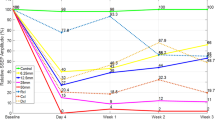Abstract
One of the crucial challenges in medicine is the treatment and rehabilitation of spinal cord injury (SCI). In this study, we established a stable and reproducible acute spinal cord injury model in adult rats. The SCI was inflicted by our self-innovated spinal cord impact device controlled by electrical circuit. The Basso, Beattie, and Bresnahan Locomotor Rating Scale (BBB) score, electrophysiology, histological, and immunohistochemical changes after SCI were observed. The BBB score of the injured rats began to increase from the 3rd day of SCI and reached at the score 7.2 ± 1.3 at the 28th day. The latency of cortical somatosensory evoked potentials (CSEP) was not observed 2 and 6 h after injury, but appeared 24 h after injury which was significantly prolonged. It recovered from day 3 gradually to 27.3 ± 2.7 ms on day 28. H&E staining showed that the structure of gray and white matter was disrupted after the SCI. The result also showed dramatic neuron degenerations, cellular swelling, and the proliferation of glial cells. The immunohistochemical analysis showed that the expression of neuron specific enolase (NSE) and neurofilament 200 (NF200) started lowering at 2 h and dropped to the bottom at 24 h. Their expression rebound from day 3 and yet to the original level at day 28 (P < 0.05). The number of cells expressing glial fibrillary acidic protein (GFAP) hiked from day 3, peaked at day 14, and began recovering from day 28 (P < 0.05). The changes of NSE, NF200, GFAP, and CSEP were significantly associated with the BBB score (P < 0.05). In conclusion, our self-innovated device can reproduce the injury model stably. The changes of NSE, NF, and GFAP after spinal cord injury reflect the characteristics of pathological change, which are closely associated with the functional recovery from the spinal cord injury.







Similar content being viewed by others
References
Yang, Y.-B., & Fu, Y.-J. (2002). Establishment and the evaluation standards of spinal cord injury models. Zhonghua Chuangshang Zazhi, 18, 187.
Yu, R.-T., Wang, Q.-P., Wu, D.-M., et al. (2005). Development of an electrocircuit controlled impact device for injuring spinal cord in adult rats. Zhonghua Chuangshang Zazhi, 21, 358–360.
Huang, L., Tang, Y., Yang, R., Shi, Y., et al. (2008). Design an universal spinal cord impact system and establishment of animal models of spinal cord contusion in rats and pigs. Zhongguo Jizhu Jizhui Zazhi, 18, 688–693.
Fu, Q., Hou, T.-S., Lu, K.-W., et al. (2001). A research on different hindlimbs locomotor assessment methods after thoracic spinal cord injury in rats. Zhongguo Jizhu Jizhui Zazhi, 11, 278–281.
Hou, W.-M., Huang, C.-G., Zhou, H., et al. (2003). Monitoring the SEP in the microscopic surgical removal of intraspinal tumors. Yishi Jinxiu Zazhi, 26, 15.
Hu, R., Yang, Y.-P., Yang, H., et al. (2008). Establishment of rat spinal cord injury model and the related pathological observations. Zhonghua Chuangshang Zazhi, 24, 279–283.
Acknowledgments
We would like to thank Jiangsu Xuzhou XINFEI Technology Co., Ltd. for providing excellent electrocircuit-controlled impacting device.
Author information
Authors and Affiliations
Corresponding author
Rights and permissions
About this article
Cite this article
Wang, Y., Liu, Cf., Wang, Qp. et al. Establishment of a Spinal Cord Injury Model in Adult Rats by an Electrocircuit-Controlled Impacting Device and its Pathological Observations. Cell Biochem Biophys 69, 333–340 (2014). https://doi.org/10.1007/s12013-013-9804-4
Published:
Issue Date:
DOI: https://doi.org/10.1007/s12013-013-9804-4




